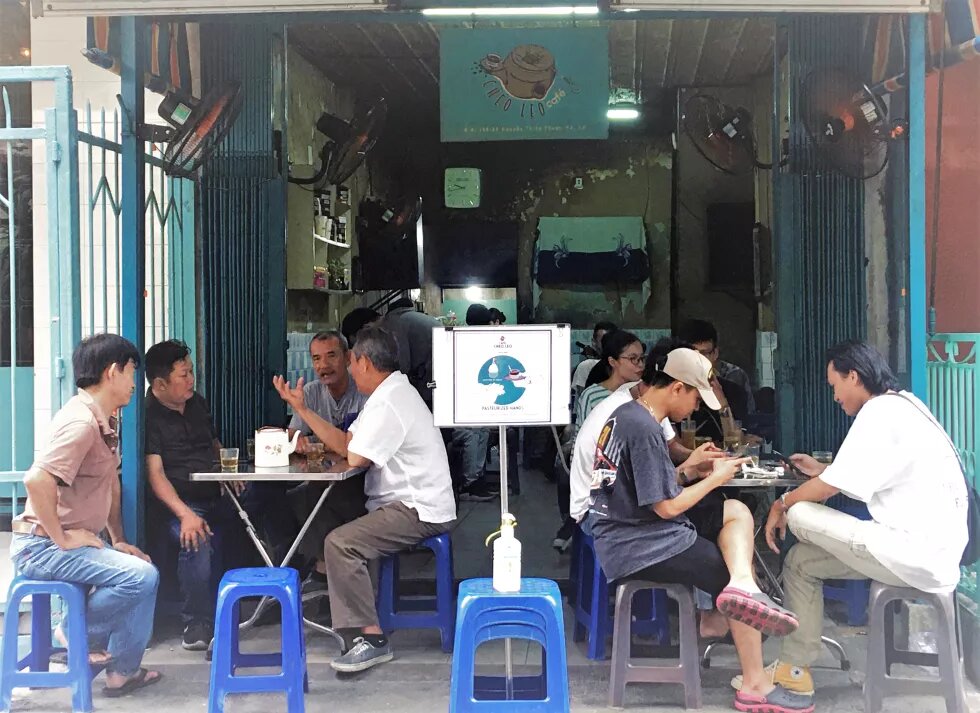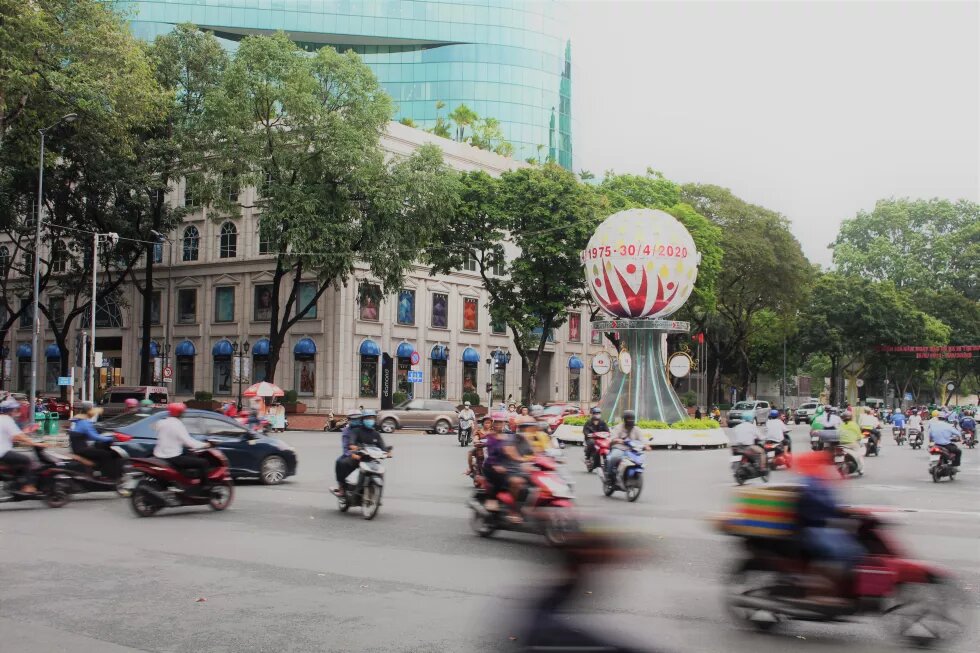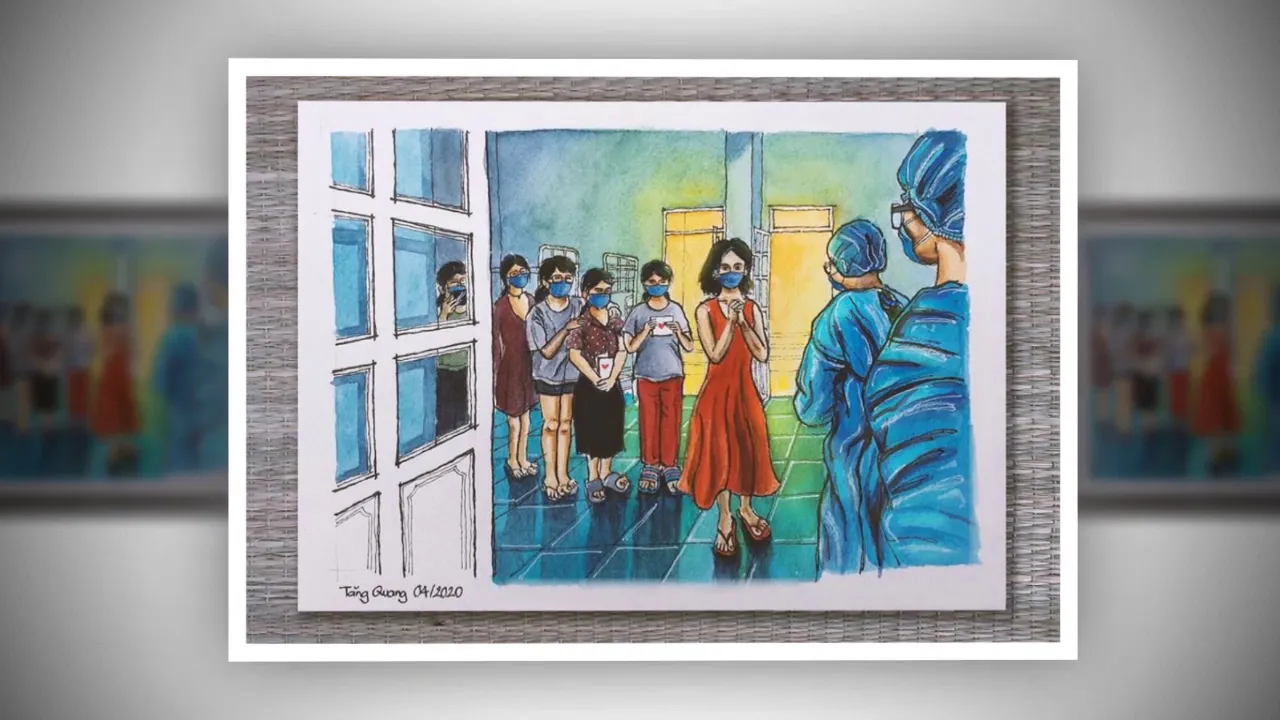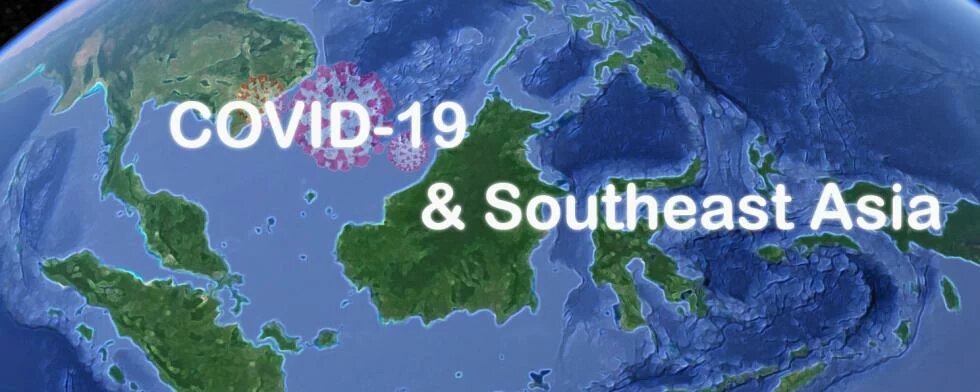
On a typical Saturday at the 82-year-old Cheo Leo coffee shop in Ho Chi Minh City, customers are enjoying their brew of strong Vietnamese coffee to the sound of sixties-era songs playing in the background. The only visible clue that Vietnam is a COVID-19-affected country is the hand-sanitizer dispenser at the shop’s entrance.

Cheo Leo reopened in late March, says Nguyen Thi Suong, its second-generation owner. She had closed the popular shop from 16 to 22 March, even before the Vietnamese government issued its 14-day stay-at-home order for the country on 1 April. During that two-week period, her shop switched to the ‘to-go’ mode because food outlets were not allowed to have dine-in customers.
“I had several safety measures following precautions from the Ministry of Health, including wearing masks, sanitizing hands, and keeping a two-meter distance between take-away customers,” Suong said. “Sales decreased a lot, but I feel secure for myself and my customers.”
From all indications, Vietnam has succeeded in managing the pandemic, an achievement that has drawn a lot of news coverage, some envy by countries in Asia and beyond, and praise from international organizations.
The 31st of May marked 45 days since Vietnam has recorded a local transmission of COVID-19. The additions to its case numbers have been coming, from time to time, through travellers from overseas coming in through repatriation flights from mid-April onwards.
As of 1 June, Vietnam’s cumulative number of COVID-19 since January stood at 328, with zero deaths, in a country of some 97 million people. Its active cases numbered just 35 as of that day. Statistics show that between 67 to 68 percent of reported cases are imported.
Since 23 April, as Vietnam slowed local transmission and put COVID-19 cases under control, its government has relaxed its physical distancing order.
A mix of safety measures, however, continue to apply to different activities. Students are back in school after nearly four months’ forced holiday since January, making Vietnam the first nation in Southeast Asia (where most schools are still closed as of June) to do so. Food and beverage outlets like Cheo Leo are back to pre-pandemic business, but need to provide means of hand sanitizing.
From 9 May onward, the government also allowed non-essential services, except discotheques and karaoke venues, to restart, but required customers to wear face masks.
Vietnamese Prime Minister Nguyen Xuan Phuc called the country’s phased reopening a ‘new normal’ that comes with caution, such as the continued wearing of masks and adopting safety measures in public areas and activities.
In its analysis of the indicators of COVID-19 impact in late May, the US-based Politico news site, ranked Vietnam as the country with the better health and economic outcomes. It called Vietnam “the overall best COVID-19 performer globally”.
But while there has been much analysis from outside about Vietnam’s response to the pandemic, what do Vietnamese themselves think?
SWIFT ACTION
“I believe that the experience from SARS (Severe Acute Respiratory Syndrome) or other respiratory diseases allowed our government to understand how these may spread and find effective methods to stop transmission and cure patients,” Suong said.
Vietnam’s swift response is no small matter, she says, contrasting it with that of the United States. “While at first, the US took the novel coronavirus danger to be part of their flu season, Vietnam considered it to be at a level as deadly as war or previous pandemics,” she explained. “When many Americans protested against stay-at-home orders and refused to wear masks, Vietnamese followed health precautions very strictly.”
Leadership is key in public health emergencies, she continues. “Victory (in this war) is impossible without the precise command of its captains,” she said, citing Prime Minister Nguyen Xuan Phuc and Deputy Prime Minister Vu Duc Dam, who is chairman of the National Steering Committee on COVID-19 Prevention and Control.
This ministerial-level committee was set up on 30 January, eight days after Vietnam reported its first COVID-19 case on 22 January. Just two days after, it suspended all flights from and to China, where the first infection was reported. Vietnam gradually closed its borders, and put a halt to all international flights from 1 April.
It had, starting 21 March, already required people arriving in Vietnam to go to 14-day quarantine at government-funded and operated facilities. In early February, Vietnam required quarantine only for travellers coming in from countries that were pandemic hot spots, but later expanded this to all arrivals.
CONTACT TRACING
Contact-tracing work was also a major weapon in Vietnam’s war against the pandemic, several Vietnamese interviewed for this article point out.
Ngo Ngoc Huyen, who worked as ground staff at the international terminal of Tan Son Nhat airport until commercial flights were suspended, says she knows that Vietnamese health officials tracked not only the first, direct contacts of people found with COVID-19, but went down the chain to the fourth contact.
“It is not just about case confirmation, but mapping the spread and circulation (of these cases), and stopping these,” Huyen explained. Depending on the nature of their interaction with people found to have the virus, as well as with others who came into contact with these infected individuals, persons are assigned to undergo different levels of quarantine. This is done under a system that classified people by degree of contact with an infected person – they are called F1, F2, F3, and F4 contacts of the first positive case, who is called F0.
The importance of using data in coping with COVID-19 is not lost on Le Do Quyen, a 25-year-old data analyst based in Ho Chi Minh City. She has a personal story to tell, sharing how she was surprised by the fast and accurate tracing of contacts of people found to have COVID-19. Her mother, she relates, was asked to self-quarantine as an F3 contact just hours after a case was confirmed in the capital Hanoi.
While there have been calls for much more COVID-19 testing in several Southeast Asian countries, Vietnam’s success has been achieved without especially large numbers of tests.
Since it has identified travel from overseas as a main channel of its few new cases these days, the country funnelled its testing efforts mainly among travellers. By 2 June, Vietnam had conducted 275,000 tests, or 2,827 per one million people. This is far below the numbers of Singapore, which has the highest testing numbers in Southeast Asia. It had carried out 408,495 tests, or 69,865 per million people by 2 June, according to Worldometers data.
To many Vietnamese, especially those who have lived through its history of fighting external powers, shaping the response to COVID-19 like a war campaign carries a lot of weight.
A veteran of the 1979 Sino-Vietnamese War, Ta Duy Tan cautions that the onset of the ‘new normal’ everyone talks about does not signal the end of COVID-19, but its shift to another stage of “fighting against an enemy”.
A CALL TO WAR
Prime Minister Nguyen Xuan Phuc himself used the war analogy when he urged Vietnamese to “fight the pandemic as fighting against an enemy” in remarks on the third day of the Tet (new year) holiday on 27 January.
“To me, that call was easy for every Vietnamese to interpret because it reminds us of the tough but heroic past of Vietnam’s wars. When it comes to (facing an) enemy, such calls will spark off the effort to resist, and win,” said Tan, whose relatives are veterans in the country’s past wars. His father fought in the war against France, and his older brothers did the same in the war against the United States.
Stressing his point, Tan, who is in his sixties, cited a well-known Vietnamese wartime saying: “When the foe comes, even the women will go into combat”.
He continued his comparison of how it is to fight the pandemic and an invader. While in past wars, the enemy can be seen and identified, COVID-19 is invisible, moves and changes swiftly. It can be deadly, but ‘fools’ people into becoming complacent against it.
Vietnam’s war-like response to COVID-19 – which involved the military working with health officials to run quarantine centers – is one that goes from the top down to the public, as well as from the individual going up, Tan adds.
Earlier on in the outbreak, the government’s steps consisted of measures to, as the official directive phrased it, “go to every alley, knock on every door, track every subject”.
Directive numbers 15 and 16, issued by the Prime Minister, spell out the measures such as types of safe physical distancing and wearing of face masks, while stressing that each Vietnamese’ contribution was crucial for victory.
“People told each other that ‘staying at home is patriotism’, or shared information about news such as the ‘ATM-style’ rice dispensers, which were being launched everywhere to help people, but without drawing crowds. Through such actions, individuals were being dedicated soldiers in a common fight,” Tan pointed out.
He also identified the other ‘soldiers’ in the public health campaign – such as doctors, nurses, airport officers, volunteers working in isolation areas.
VOLUNTEERS AS ‘SOLDIERS’
It was midnight when Nguyen Thi Cam Tu, a 21-year-old junior at the Vietnam National University in Ho Chi Minh City, decided to volunteer in preparations so that the university dormitory could host the waves of travellers from overseas who needed to go into quarantine. Volunteers like her helped Vietnam’s armed forces get enough quarantine venues ready.
“I saw a post on Facebook at 11 PM, calling for volunteers to help prepare the dorm the next day. It was still being used by students, who needed to vacate,” recalled Tu. “At the scene, I felt like a soldier in the fight against COVID-19, but without my wearing the white blouse of a healthcare worker, or the green uniform of a military official,” Tu said.
These days, Tu the ‘war veteran’ is back at on-campus classes at her university, four months and several online modules later. She sees her friends and lecturers, quite relieved that she does not have to be stuck to her laptop everyday.
Before other countries had implemented quarantine policies, Vietnam put into motion an operation to set up quarantine facilities by harnessing its armed forces. The government also shouldered quarantine costs regardless of the nationality of the persons involved, as a tool to prevent widespread COVID-19 transmission within the community.
The Vietnamese Army has set up and looks after 159 isolation areas across the country. As of 3 June, the persons in quarantine numbered 71,127, and 66,721 of them have finished their 14-day schedules, according to the National Committee for Incident, Disaster Response and Search and Rescue.
The role that medical, health and military personnel, as well as volunteers, played in their care is clear to people like Nguyen Tang Quang, a returning student who made a picture book of the sketches he did during his 14-day isolation. After flying home from Britain, he went into quarantine at the Seventh Military Zone School in Ho Chi Minh City.
“In the (quarantine) zone, I felt safe, and treasured the efforts that officials and doctors made. I and other people were taken care of very well without any disruptions in study and work (for those who had to continue with these),” Quang recalled.
His social-media posts of his sketches became very popular. Quang added, “At first, I just wanted to show my appreciation for the military officers and kill time. I did not expect its viral effect.”
Suong, the coffee shop owner, adds that she is aware of questions and some doubts around Vietnam’s reported number of COVID-19 cases and deaths. “So how many COVID-19 infections and deaths are correct and can be verified?” she asked, addressing sceptics. Such talk, she believes, misses the point – which is that she has been able to reopen the coffee shop that her late father started. Now in her sixties, Suong says she does not need precise numbers to see that Vietnam has been able to bring COVID-19 under control.
At the same time, Tan, the war veteran, says that a lot of recovery work lies ahead, not least given the economic impact on individuals and companies. The Vietnamese government has issued an unprecedented assistance and stimulus package valued at 62 trillion Vietnamese dong (more than 2.6 billion US dollars), and its distribution is underway.
STILL FORTUNATE
Meantime, there are worries about people letting down their guard in the face of Vietnam’s success in reining in the pandemic.
“As you see here, people are a bit careless, removing their masks, ignoring safe distancing, and are just enjoying their beer and conversations with friends,” Quyen said, referring to diners in the crowded beer and grill where this interview was held.
At the same time, Ngo Ngoc Huyen, the airport staffer, says that Vietnamese need to bear harder times in order to move on.
“We endured hardships but had to accept this to prevent the pandemic from spreading, and to protect ourselves and other people,” said Huyen. As for herself, she says she is still “fortunate” to have found some irregular work, for now, at the domestic airport terminal in Ho Chi Minh City.
__
This article is published by Heinrich-Böll-Stiftung Southeast Asia and Reporting ASEAN
Reporting ASEAN is a homegrown, independent venue for the discussion of news and issues around regionalism, highlighting voices and views from within Southeast Asia. Its focus includes coverage of the idea of an ASEAN, which goes far beyond the regional association ASEAN, as well as the training of journalists from the region. It follows conversations around the news media and journalism in Southeast Asia, from disinformation and misinformation to interesting ways of storytelling.
This article is a part of Web-Dossier: COVID-19 and Southeast Asia






